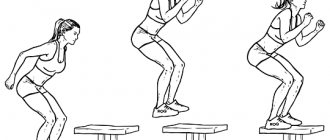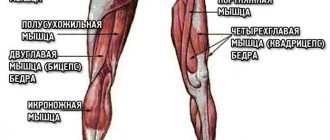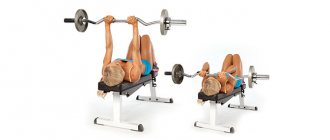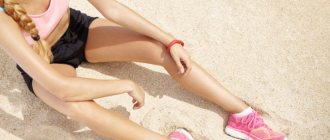A set of special running exercises will help correct inaccurate movements or running technique. When performing intense exercises, almost all muscles are involved, and accordingly, the power of the whole body increases.
Running involves many muscles that perform different functions. In order for the muscles not only to receive physical activity, but also to form the correct structure of movements, special running exercises (SBU) were developed. This is a set of running exercises aimed at developing strength, power and coordination of all leg muscles involved in running. Specific running exercises will enhance the specific physical and technical fitness required for running. Each of these exercises is a separate accented element of running.
SBU is precisely a set of exercises, so you always perform at least 5 exercises in a series. Experienced coaches include the SBU complex in every warm-up. The length of the segment for performing SBU depends on the purpose of the exercise and the preparedness of the performer. For a special warm-up – from 20-40m; for training – 60-70m. The number of repetitions is from 1 to 6 times.
Don't miss: Physical Fitness for Runners: 30 Bodyweight Exercises
What are the benefits of running in place?
The training format allows you to saturate the cells with oxygen if you ventilate the room 20 minutes before the start of the workout. Oxygen is distributed throughout the body, and the body works at increased pressure, thus consuming energy from carbohydrates and fats, warming up muscles and improving capillary function.
At the same time, running in place will not require you to change your training schedule due to rain or wind outside. You decide when you start training and spend 15-30 minutes running. Plus saving time - you don’t spend it going out and returning home, which is a good 30-40 minutes a day.
Running in place improves metabolic processes, promotes cell renewal, and helps launch rejuvenation processes in the body.
First of all - warm up
In athletics, much attention should be paid to warming up. It is always necessary and under any circumstances, regardless of the distance. What does warm-up do for an athlete? In this case, we can say unequivocally - everything. You warm up your body, stretch your muscles and tendons, gradually increase blood circulation and prepare your heart for increased stress.
If you start training without prior preparation, you may experience pain due to the fact that all the muscles of the body will be tense. In addition, an increased load is created on the “engine”, which cannot affect a person’s well-being. Under no circumstances should you start running fast without warming up, as this will lead to muscle spasms or damage to ligaments.
How long should you run at home to lose weight?
The duration of training at home must be increased gradually. Experts recommend starting with short sessions lasting 2-3 minutes and then moving on to standard workouts. How many calories running in place burns is important to consider when planning the duration of the program.
- To consume 100 kcal. It takes about 20 minutes .
- 200-300 kcal. can be burned depending on 30 minutes of intense running.
- Classes lasting up to 40 minutes are most effective.
The pulse should be frequent, but not more than 140 beats/min to prevent overload of the heart and blood vessels.
The average duration of weight loss workouts is 20-40 minutes. The first results will appear in 2-3 weeks.
How to run in place correctly and where to start
The training process begins as standard - with warm-up and stretching, which will prevent you from straining your knee or spraining your foot. The complex includes exercises for rotating the arms, legs, and lateral stretches to increase flexibility and warm up the muscles. Emphasis is needed on the knees and ankles, joints and ligaments.
Be sure to warm up before your race
This will help prevent stress and injury.
Beginner athletes are recommended to start training with small jumps and light bouncing for 3-5 minutes. After which the intensity and duration of training increases. After 2-3 weeks, the body’s endurance will increase and you can plan a change in load and running methods.
The effectiveness of jogging on the spot is achieved by including it in a set of exercises and creating sets. Therefore, to lose weight, it is recommended to add jumping rope and a few basic exercises to running.
An example of an integrated complex:
- 10 minutes jogging;
- Ab crunches;
- push ups;
- press rack;
- continuation of running.
Start running in place as gradually as you would any other activity. Don't forget to stretch and warm up before and after your race.
Execution technique
To get the maximum effect from running, it is necessary to take into account the execution technique, calculate the required pace, exercise time, and heart rate. And along with the obvious points, it is important to follow a training schedule - run 4-5 times a week.
Running technique means the following rules:
- Keep your back and body straight so as not to put stress on your spine.
- The arms are bent at the elbows and pressed to the torso, the cries are lowered and relaxed.
- Alternately move your legs to simulate a jog.
- Landing and pushing off are important toes for maintaining healthy joints.
- Don't lean on your heels.
- Raise your knees higher to increase the effectiveness of the exercise.
If the shoulder joints are tense, the training will not be effective, because This position helps retain energy and reduce metabolic processes.
It is not recommended to lower your head and look at your feet when training. Look forward; in the absence of external obstacles, when moving in place, training is safe and does not allow you to stumble and fall.
Correct running technique and body position can reduce tension in the spine and lower back and save energy costs.
Comprehensive physical rehabilitation program for patients in the experimental and control groups
. I. p. - standing. Walk calmly with high hips, 1-2 minutes.
. I. p. - lying on your back, legs together, arms to the sides - and. n. - inhale, bend your leg at the knee, wrap your arms around it, press it to your stomach - exhale. Alternate with each leg 5-8 times.
. I. p. - the same, arms along the body. Simultaneous abduction of straight arms and legs to the sides - inhale, and. p. - exhale. b-8 times.
. IP - the same, hands on the belt. Alternating straight leg raises (vertical scissors). 6-8 times with each leg. Breathing is free.
. I. p. - the same. Alternate circular movements of the legs in the hip joints raised at an angle of 45°. 6-8 times with each leg. Breathing is free. Final part.
I.p. - standing, feet wider than shoulders, hands on the belt. Circular movements of the body. 6-8 times in each direction. The pace is average.
I.p. - standing, legs apart, hands in front of the chest. Turn your torso to the side while simultaneously raising your arms - inhale, and. p. - exhale. 6-8 times in each direction.
-Y. p. - standing, walking with acceleration, switching to easy running and again walking with a slower pace. Breathe freely, 2-3 minutes. Complex 2
An approximate set of exercises for obesity degrees 1-11. (reinforced, variant)
Introductory part.
1st n. - main stand. Walk in a circle with your hips raised high, maintaining correct posture, 1-2 minutes.
2nd. p. - the same. Walking on your toes with your arms out to the side, 30-60 seconds.
-Y. p. - the same. Walking at an accelerated pace, turning into running, slowing down, slow walking with arm movements, 1-2 minutes.
. I. p. - standing, legs apart, hands below, fingers clasped. Raise your arms up, stretch, rise on your toes - inhale, and. p. - exhale. 4-5 times. The pace is slow.
. I. p. - basic stance, arms to the sides, bend back - inhale, and. n. -exhale, 6-8 times. The pace is average.
The main part (exercises 1-9 are performed with dumbbells).
1. I. p. - standing, legs apart, arms along the body. Rising on your toes, arms up - inhale, and. p. - exhale. 6-8 times. The pace is average.
-Y. p. - standing. Bend your elbows, arms on your chest, at the same time take your right leg back, bend over - inhale, and. p. - exhale. 6-8 times. The pace is average.
. I. p. - the same, hands on the belt. Turns the body to the right and left. 6-8 times in each direction. Breathing is free.
. I. p. - main stand. Move your leg to the side on your toes while simultaneously tilting your torso in the same direction - exhale, and. n. - inhale. 5-6 times in each direction.
. I. p. - standing, feet wider than shoulders. I. p. - inhale, bend forward, swing your arms back, bend your back, look straight ahead - exhale. 4-5 times. The pace is slow.
. I. p. - the same, one hand at the top, the other at the bottom. Vigorous change of hand position. 6-8 times with each hand. Do not hold your breath. The pace is average.
. I. p. - main stand. I. p. - inhale, sit down, stretch your arms forward - exhale. 6-8 times. The pace is average.
. I. p. - standing, legs wider than shoulders, arms to the sides. I. p. - inhale, bend forward, touch your left foot with your right hand - exhale. 6-8 times in each direction. The pace is slow.
. I. p. - the same, hands down. Spread your arms to the sides, bend over - inhale, clasp your chest with your hands - exhale. 6-8 times. The pace is slow.
. I. p. - sitting on the edge of a chair, leaning back. Vigorously draw in your stomach, then relax it 5-7 times. The pace is slow.
. I. p. - lying on your back, arms to the sides. Raise your legs vertically, then slowly lower them to the sides. 8-10 times. Breathing is voluntary.
. I. p. - the same, hands under the head. Raise your legs up. Slowly lowering your legs, make circular movements in your hip joints in and out. 6-8 times. Breathing is voluntary.
. I. p. - lying on your back, arms along the body, legs bent. Raising the pelvis with a transition to the half-bridge position - inhale, and. p. - exhale. 6-8 times. The pace is slow.
. I. p. - the same, arms bent at the elbow joints. Bending the spine in the thoracic region with support on the elbows - inhale, lowering the chest - exhale. 6-8 times. The pace is slow.
. I. p. - lying on your back, one hand on your chest, the other on your stomach. Deep chest and diaphragmatic breathing. 4-5 times.
. I. p. - the same, arms along the body. Alternate flexion and extension of the legs at the knee and hip joints (“bicycle”), 10-12 times. Breathing is free.
. I. p. - lying on your back. Deep breathing 4-5 times.
. I. p. - the same. Hands under head. Raise your legs slightly straight, spread them apart and cross them. Return to i. p. 8-10 times. The pace is slow.
Go to page: 15
Ways to increase the load
To lose weight and create a beautiful body contour, additional physical exercises are included in your workouts. Experts recommend alternating running with anaerobic techniques - push-ups, exercises with weights, dumbbells.
Incorporating exercises with a skipping rope will help you lose weight and give you a slimmer figure in a short period of time.
The load on the leg muscles is achieved using the following basic techniques:
- running with knees raised;
- running with choking of the shin;
- mixed media.
The knee lift and shin wrap technique is used to increase intensity, but only for short periods of time.
Running in place with knees raised
Jogging in place with high knees is an intense endurance workout for the body due to the stress on the ligaments and joints. But this technique is used only after warming up and if you have experience in running. Start with a normal run, and then add challenging elements like knee lifts or shin sweeps. Training with high knees increases the load and therefore reduces the duration of training.
Raising your knees when running is an enhanced cardio workout that works your calf muscles and thighs. The abs, by raising the legs, the lower back, the back, and the buttocks are also involved. When incorporating technique into your training routine, you can take short breaks between intense runs. Options for a training complex are selected in accordance with the state of the body.
Example of alternating loads:
- Running in place - 12 minutes
- Running with knees up - 20 seconds
- Running in place - 1 minute
- Walking - 10 seconds
- Run in place for 3 minutes
- Running with knees up - 20 seconds
Running with knee raises is included in the workout to increase load and intensity.
Running with shin sprains
Jogging with shin overlapping requires the body to be leaned forward. During exercise, you need to raise your shin high, trying to touch your buttocks with your heel. The workout is intense, but the load on the legs and pelvis is less than when jogging with knees raised. The intense load in the exercise falls on the buttocks and back of the thighs. The technique allows you to reduce weight, create a beautiful silhouette, tone the body, and launch the process of restoration and rejuvenation of the body.
Mixed running technique
In mixed training, you alternate between different types of running, strength movements and cardio exercises. The training time takes approximately 30-35 minutes. The training complex can take place in the following sequence:
| Technique | lead time |
| warm-up for the body, including twisting the body, swinging the legs and arms | 2 minutes |
| jumping in place in the standard way or with legs apart, moving forward and backward | 1 minute |
| standard run at a moderate intensity pace | 3 minutes |
| speed run | 2 minutes |
| running at an average pace | 3 minutes |
| steps in place | 1 minute |
| running with high knees | 30-60 seconds |
| standard run | 1 minute |
| walking | 30 seconds |
| repeating cycles of running with legs raised high, classic jogging and walking | 2 times |
| jogging with shin grabs | 1 minute |
| simple running | 1 minute |
| running with shin grabs | 2 minutes |
| standard run | 1 minute |
| running with shin grabs | 2 minutes |
| simple running | 1 minute |
| race walking | 1 minute |
| simple running with breaks for walking (cool down) | 5 minutes |
After jogging, muscle stretching techniques are performed. Changes can be made to the programs in accordance with the level of training.
Experts do not recommend starting complicated exercises in the absence of regular training. You need to start with a simple run and then rest.
Basic exercises to improve your running quality
To improve your running, it's not enough to just run. By doing specific exercises like the ones listed here for 20 minutes at a time, you can significantly improve your running form, running economy, and speed. They can be performed as a dynamic warm-up after a 10-minute easy run and before the main distance, or after the main workout.
Perform these exercises three to four times a week, making sure to use proper technique. You can add other exercises, such as acceleration, but the most important thing is to be systematic.
Backward shin sweep Why: Works the quadriceps, emphasizes the recovery phase of the running step cycle How: Perform the exercise in place, try to maintain a more or less neutral position of the hips, instead of using the strength of the muscles of the hamstrings, think about how best to “pick up” the leg, the quadriceps should work, glutes and hip flexors, and then “drop” it back to the ground under your center of gravity. The body must remain straight. This exercise helps improve dynamic range of motion. Perform two to four repetitions 15 times with each leg.
Running with a high hip lift Why: This exercise helps improve the work of the knees, glutes, and quadriceps muscles, which play an important role in the speed and efficiency of running, and running in place emphasizes the need to lift the foot off the surface instead of pushing off forcefully to initiate a new step. How to: Run in place at a very high pace, with your hips alternately rising up to form a parallel line with the floor. Make sure that the landing on your foot is soft and springy, and do not put your entire body weight on your foot. Perform 2-4 repetitions 15 times with each leg.
Running with an accentuated push-off (jumping running) Why: Jumping jogging strengthens the muscles of the feet, calves and quadriceps. They also help develop stability on one leg. How: On flat or slightly hilly terrain, alternate jumping up, pushing leg straight, leg going up, performing an exaggerated galloping movement. It is important to focus on a powerful jump and perform the exercise at a fairly high speed. The movement of the hands is in antiphase. Stand straight for a moment between jumps. Perform three or four repetitions 10 times with each leg.
Leg Crosses Why: This exercise relaxes the hip flexors and gluteal muscles, improves the mobility of the hips and buttocks, and also strengthens the lateral thigh. How to: Stand straight and begin to move to the right, bringing your left leg in front of your right. Then, moving in the same direction, cross your left leg behind your right. The same thing in the other direction. Perform two, four repetitions of 50 meters to the right and left.
Slow Jumps Why: This exercise helps strengthen the muscles in your calves and feet. It also stimulates neuromuscular function for high-paced running. Perform 2-4 repetitions of 50 meters.
Jumping to the side Why: This exercise strengthens the lateral surface of the thigh and develops agility, helps to better maintain balance. An exercise for the muscles of the buttocks, hip flexors, tensor and abductor muscles, and the muscles of the lower back, which are not used when running forward. How to: Stand up straight, move sideways with side steps. You may find it more comfortable to do the exercise with your hands behind your head to maintain balance. Perform 2-4 repetitions of 50 meters to the right and left.
Swing your legs forward Why: This exercise improves leg mobility, quadriceps and gluteal muscles, which are responsible for your speed and proper technique. How to: Keep your body straight, alternately lift your straightened leg forward and at the same time bring your opposite arm forward, trying to reach the tip of your foot. Technique is more important, not speed. Perform two to four sets of 10 times with each leg.
Stiff Leg Running Why: This exercise helps improve neuromuscular function for running at a fast pace, as well as correcting poor foot placement. How to: Stand tall with your legs straight and toes pointing forward, moving forward at a fast pace without bending your legs. Don't lean your body back. Perform 2-4 sets of 50 meters.
Running backwards Why: Running backwards strengthens your glutes and quadriceps, as well as your abdominal and lower back muscles. How: It will feel weird at first, but still try to do the same movements as you would when running normally. The work of the arms and feet is approximately the same, but the quadriceps and core muscles will perform a different task. It's the form that matters here, not the speed. Perform two or four sets of 50-100 meters.
Source
Heart rate during exercise
Pulse and its frequency are an important component in any cardio training, and even more so when running. Monitoring your heart rate allows you to regulate the load during training, accelerate steadily and reduce speed in time.
It is easy to calculate the maximum heart rate (HR) using the general formula: 220 minus - your age.
For example, 220-28=192 is the maximum heart rate for a 28-year-old girl.
- You begin to lose weight when your heart rate reaches 60%-70% of the maximum frequency. Again, for a 28-year-old girl, comfortable fat burning will begin in the heart rate zone of 120-140 .
- The heart rate limit zone is 90%-100% of the maximum heart rate. In this zone you can work through explosive jerks, but only for trained athletes.
To find out your maximum heart rate during training, you can run with a wristwatch that has a heart rate detection function and thus track your heart rate zones.
Knowing your heart rate zones will help you determine which heart rate zones you should run in to lose weight and still feel comfortable.
Exercise group 5 - Short accelerations
You may ask me the question: “if I need to improve my running technique, how can running help me with this?” Sprints are short, fast runs that last 15-25 seconds and are performed at high, but not maximum, speed. It's similar to a sprint, but still not quite one.
For most people, the faster you run, the better your form (at least for a short period of time until you get tired). High running speed is achieved due to more efficient transfer of forces. Thus, by performing accelerations, you accustom your body to more efficient movements, that is, to better technique. Of course, maintaining technique throughout the entire acceleration period is a very important factor. So if you find it difficult to maintain high speed after 20 seconds, reduce the acceleration time to 15 seconds to prevent your technique from falling apart. The length of rest between accelerations can vary, but it should be long enough so that you can perform the next acceleration with relative ease. As a rule, a rest of 45-60 seconds is sufficient.
Breathing while running
When asked whether running in place is beneficial or harmful, it is important to consider the load and technique, because they greatly affect the runner’s breathing.
Breathing technique when running: rhythmic breathing, inhale through the nose, exhale through the mouth. The exhalation should be 2 times longer than the inhalation. However, during training on the spot, you do not bother with the pace, beat, running speed and do not try to adjust your breathing to these parameters. Therefore, when jogging in place, it is easier to breathe steadily. To maintain the heart rate zone limits, parameters must be measured regularly during training.
When practicing in a room, it is important to regularly ventilate the room to saturate the body with oxygen. If necessary, you can move the training to a loggia or balcony.
Athletics for health
Despite the fact that athletics is characterized by fairly simple exercises, they should be treated carefully. Never do something that is difficult for you. The body should receive its “charge”, but not overwork. Monitor your pulse, and it is also advisable to visit a doctor occasionally so that he can monitor your general physical condition.
Regular training will lead to the fact that the general physical condition will be normal, the state of health will be excellent, in principle, as well as the mood.
More on the topic:
- How to choose the right bike for your child
- Choosing a children's bike
Shoes and clothing
A big plus in choosing equipment for running on the spot, and even at home, is that you can wear what you feel comfortable in and you don’t have to think about how you look. Even if it is an unsportsmanlike T-shirt or short shorts, in which it would be embarrassing to appear in the gym, the main thing is that the clothes do not hinder movement and the skin in them breathes easily.
High-quality shoes are needed, with shock absorption on the heels and ankle protection. Sneakers should fit securely on your feet without squeezing your foot. Tight models contribute to the formation of edema and can lead to injury.
When choosing sneakers in sports stores, ask the consultant to suggest running sneakers and always with cushioning for your feet
How to start running
Now you know how to run correctly, then you need to move on to practical exercises. You need to build momentum consistently, so don't chase speed or run time. Now the main thing for you is quality and correct technique.
Start by jogging.
Program for Beginner Runners
It is advisable that a trainer develop a training plan for you - he will take into account your initial data, physical fitness, and health characteristics. And he will monitor the implementation of the plan. But if you don’t have an experienced mentor, you can stick to the average program.
Training program for beginner runners.
The data is approximate. You can change them smaller or larger, depending on how you feel.
The most important rule: at the initial level of training, you should combine running with walking:
- in the first week, 1 minute of running, 2 minutes of walking.
- in the second week, 2 minutes of running, then the same amount of walking.
- in the third week you need to run more than walk - run 3 minutes, walk 2 minutes, etc.
Indicators should increase gradually so that the body gradually gets used to physical activity.
Training pace
You're still learning to run, so keep it at a pace that's comfortable for you. Training too aggressively can lead to injury or rapid exhaustion, causing you to become disillusioned with running and give up on it.
Approximate speed: 5-7 minutes per 1 km.
Try talking while running:
- If you can talk freely, then you need to run faster.
- If the words come out of your throat sharply, with wheezing, then you have taken the pace too fast.
Stick to the middle where you can speak in short sentences.
Duration and frequency of classes
You need to train 3-4 times a week for 20 minutes.
You don't need to expect to run non-stop for the entire twenty minutes. We ran or walked, caught our breath and gave our bodies a rest. We started running again.
Try to reduce your rest periods over time. After 10-12 workouts, you can reach 30 minutes of non-stop running at a calm pace.
Contraindications
When planning your workouts, consider your health status. If you feel unwell, it is recommended to postpone training until you recover. It is not recommended to run if you have the following symptoms:
- arrhythmia;
- heart disease;
- thrombophlebitis;
- heart failure;
- arthrosis
It is best to get tested and consult a doctor before training. Without warming up and stretching, joint damage and injury are possible. Older people need to start training with minimal load.
To prevent harmful effects, it is necessary to select a level of exercise that is suitable for physical fitness.
Memo
- Running in place improves metabolic processes, promotes cell renewal, and helps launch rejuvenation processes in the body.
- The average duration of weight loss workouts is 20-40 minutes. The first results will appear in 2-3 weeks.
- Start running in place as gradually as you would any other activity. Don't forget to stretch and warm up before and after your race.
- Correct running technique and body position can reduce tension in the spine and lower back and save energy costs.
- Knowing your heart rate zones will help you determine which heart rate zones you should run in to lose weight and still feel comfortable.
- When practicing in a room, it is important to regularly ventilate the room to saturate the body with oxygen. If necessary, you can move the training to a loggia or balcony.
- It is best to get tested and consult a doctor before training.
Do not neglect warming up and cooling down before and after a run, this will protect you from injuries and sprains. Do you want to know how to get your body in perfect shape and lose excess weight? We will send you simple and useful tips absolutely free of charge.
Enter your email and click the download button ↓
Running - health benefits
Some say: “Jogging is the cure for all diseases and the best fitness trainer.” Others claim that running is one of the activities that “kills” the knees and spine. And in general, the running topic is more PR and window dressing than real benefit. Today we will try to understand the topic of “running”, find the advantages of such training and debunk popular myths.
What are the benefits of running? 5 reasons to start running
| Longevity | |
| Run Regular running combined with proper nutrition slows down aging by 10 years | Alternative A lifelong Mediterranean diet will also extend your life by 10 years |
| Excess weight (“burn” 1 cake 360 calories) | |
| Run 5 km run | Alternative Wash the car by hand for 1 hour |
If these facts do not convince you to go for a run, then here are 5 benefits of running:
- The most budget sport. For training you only need special sneakers, that’s all. You can keep your body in shape without a gym membership, meal plan, or purchasing special equipment or uniforms.
- Blood oxygen saturation. During jogging, circulatory activity increases 5 times. This means that gas exchange and metabolism in cells is also active.
- Running clears your head. During such a load, thoughts turn off, rhythmic breathing introduces you to a state of meditation. Therefore, interesting ideas often appear during a run or immediately after it.
- Running is suitable for people of any size and level of physical fitness. After all, jogging is a very fast step. And everyone can walk. By the way, the largest age category of amateur runners is 45+.
- Muscles and ligaments are strengthened. Jogging has a positive effect on the entire musculoskeletal system. Therefore, this is the best prevention of arthritis, arthrosis, and osteoporosis.
What health indicators can running affect?
1. We are less nervous and worried. Running activity increases gamma-aminobutyric acid (GABA) concentrations. This substance is a neurotransmitter of peace and tranquility that fights stress.
2. We feel happier
Running for weight loss in the morning or before bed not only improves your figure, but also gives you a feeling of happiness. It’s not just about the psychological: “I went for a run, I ran, I’m great,” but about very real hormones - endorphin and endocannabinoid. These substances act as analgesics that relieve pain in aching muscles and ligaments. Dopamine and serotonin are also produced during running. The latter hormones are mega beneficial for health, as they protect against depression, bad mood, low self-esteem, and psychosomatic diseases.
3. We think more clearly, even as we age. The oxygenated brain begins to work more actively, and creative ideas and non-standard solutions to problems arise in the head.
4. We age more slowly. Under metabolic stress (long running), body cells are transferred to energy saving and recovery mode. After training, oxygenated blood triggers tissue regeneration and activates the synthesis of elastin and collagen (proteins of youth).
5. We become healthier. Regular jogging in any weather strengthens the immune system and increases physical endurance.
Running for beginners
For regular running exercises, it is necessary to prepare the foot apparatus. Therefore, beginner runners are recommended to do SBU (special running exercises) in addition to training. For example, running with your legs thrown back so as to touch your buttocks. A good option is to stand on your toes on a small elevation (step) so that your heels hang down, and raise yourself on your toes 10 times in 3 sets. This load will strengthen the ankle and help when running.
How to start running
Simple: buy special running sneakers 0.5 sizes larger than regular shoes (the feet swell during physical activity), find comfortable clothes and go out on the treadmill in a good mood. It's good for beginners to join a running club. It will be easier to train in a circle of like-minded people and there will be no problems with embarrassment or motivation. Plus there will always be company for jogging.
Jogging technique
It's simple: we push with our foot, bring our foot forward, land on our toes, and then on our heel. In this case, we tilt the body slightly forward, and the arms, bent at the elbows, move in time with the legs.
Step frequency (cadence) is important in proper jogging. Rhythmic music in the player will help you set them up. With the correct cadence, the runner does not hang in the air, distributes the load evenly and maintains a stable speed over long distances.
It will be difficult to adjust your body position and step frequency at first, but the body will quickly get used to the load.
You don't need a training plan
If your goal is not to participate in races, but to improve your quality of life, then just start running 15 minutes a day. Monitor your pulse and breathing, gradually adding time every week (5 minutes). How long to train in the end (duration of the race and distance) – choose for yourself. For beginners, it is not advisable to run for more than 30 minutes in the first weeks. It's better to run for 15 minutes and then add flexibility exercises at the end of the workout.
Where is the best place to run?
“Where can I run?” is the question all beginners ask. Advice from a trainer and personal experience of famous runners call special running tracks with a rubberized surface in stadiums or parks, and running arenas the best location for training. During the cold season, classes can be carried out on treadmills. Running for beginners is a task involving overcoming physical and psychological discomfort. Jogging or dirt paths in wooded parks, forests, and recreational areas are suitable for this.
Morning or evening running?
It all depends on your daily routine, work schedule and whether you are a morning person or a night owl. Running in the morning will wake you up better than any alarm clock, and your brain, charged with oxygen, will be prepared for the start of the working day. But this format requires getting up at 4.30-5 am. Warm-up, running itself, warm-up, shower, breakfast, going out and going to work - there is no escape from this. Therefore, morning jogging is often chosen by freelancers, creative people, and workers with a flexible schedule.
Running before bed is an ideal solution for night owls. Physical aerobic exercise will relieve the brain and remove the effects of stress after a hard day. Oxygen saturation and pleasant muscle fatigue will help you fall asleep faster. Plus, there are no time limits, and the runner himself regulates the duration and intensity of the workout.
Proper breathing when running
For running at a slow and medium pace, it is recommended to take 1 breath per 3-4 steps, and exhale for the same duration. For beginner runners, this pace will help protect the lungs from hyperventilation, avoid liver tingling and dizziness.
How long should you run?
The best option for a beginner would be interval running, when running alternates with walking. For example, run for 5 minutes, 5 minutes to restore your breathing and rhythm. Interval running of such alternations can include 3 times at the beginning (total training time 30 minutes), gradually increasing the distance and time.
About the benefits of training scientifically and objectively
How does running actually affect the quality and length of life? Scientists in large-scale studies have found that regular jogging reduces the likelihood of developing cardiovascular diseases by 45%. On average, runners live 3 years longer than their peers who don't enjoy running.
Running training program
If your goal is not only health, but also good performance in races, then you cannot do without running plans. The level of load, duration of running and distance depend on the age, physical fitness, and level of training of the person. And the running plan takes this into account.
A sample runner's schedule looks like this:
- Monday: 5 minutes warm-up, 15 minutes running, 5 minutes cool-down (stretching).
- Tuesday: jog for 20 minutes.
- Wednesday: Closed day.
- Thursday: 5 minutes warm-up, jog 15 minutes, cool down.
- Friday: 20 minutes of interval running (5 minutes walking, 5 minutes running).
- Saturday: jogging 15 minutes + stretching.
- Sunday is a day off.
Losing excess weight: walk more
Do you dream of toning your body and tightening your silhouette? Then healthy eating and jogging will help. But for people with stage 2 and 3 obesity, it is better to start with walking.
For the rest, nutritionists and trainers advise:
- To lose weight, run at a low heart rate. Special sensors or smart watches give a signal when the pulse exceeds 160 beats. Then slow down or take a step. This load is suitable for those who are overweight and have an untrained cardiovascular system;
- Lesson duration: from 30 minutes. Exogenous fat (subcutaneous fat layer) begins to melt after half an hour of aerobic exercise. If you don't have enough stamina, then first go at a fast pace for 15 minutes, and jog for 15 minutes.
Running and spine
Jogging is not only a great cardio workout, but also a challenge for the musculoskeletal system. Amateur and professional runners give one piece of advice: do not skimp on quality running shoes with good cushioning. There should be several pairs of them for different routes, seasons, and duration of the run.
To avoid injury, trainers advise beginners:
- do not chase the intensity of training;
- monitor breathing and pulse;
- run during daylight hours.
Running and stress
Running in the morning or before bed can replace a psychologist and antidepressants. Prolonged aerobic physical activity and measured breathing balance the work of the sympathetic and parasympathetic parts of the peripheral nervous system. It is he, and not the central nervous system, that suffers most from the effects of stress (tremor, increased sweating, sleep disturbance, dizziness, muscle weakness).
In addition, if you run for 1-1.5 hours every day, the body synthesizes a colossal amount of endorphins, dopamines, and serotonin - hormones with analgesic and antidepressant effects. Here is the answer to why running addiction occurs in people of different ages and levels of physical fitness.
The main thing is to choose a convenient time for training. Let it be morning or evening, a treadmill in the gym or park. The next step is to let go of all thoughts and just run and breathe.
FAQ
1. I want to start running, but I have hypertension and am already slightly over 55. How is running useful for a retired person with a heart condition?
Jogging is a type of cardio exercise. Such loads normalize the functioning of the cardiovascular and respiratory systems, strengthen muscles, and increase endurance.
2. How long should you run when you're over 40?
Running for beginners at your age is an easy jog for time, not for kilometers. First, run for 5 minutes, then 10, and then gradually increase the duration of the exercise. With daily exercise, your blood pressure will normalize, your health and well-being will improve.
3. Can I train in regular sneakers?
Not recommended. These shoes do not provide shock absorption to the foot. Running in sneakers risks foot and knee injuries. 4. Is it possible to run 3 months after giving birth?
Yes, if you start with 15 minutes of light jogging, gradually increasing your training time.
5. I run 10 km every day, but I’m not losing weight. What's the matter?
You need to get tested. There may be an imbalance of hormones that affects metabolism. And reconsider your caloric intake.










